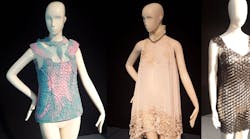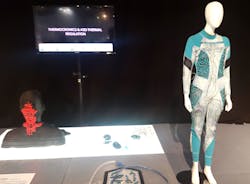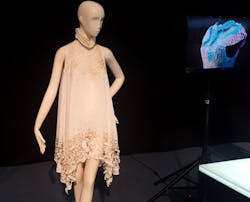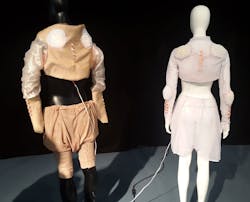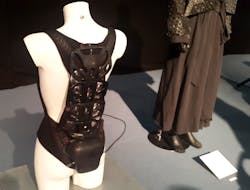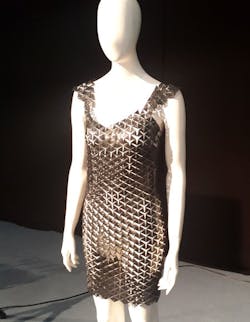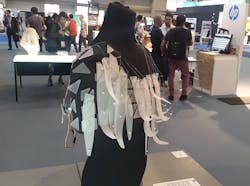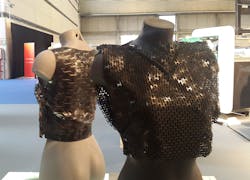One highlight of the recent Barcelona Industry Week was an area devoted to 3D-printed fashion. While wearables and 3D printing are getting all of attention, this demonstrated how these technologies can be creatively incorporated into the world of clothing. Material science, thermodynamics, and electronics are just a few of the technologies emphasized.
1. Thermocromics and autistic spectrum disorder thermal regulations
Nada Elsonni created this pattern by mimicking the veins of the body. The garment is to help people with Autism and their care taker, detect, learn, and cope effectively with their sensory processing disorder by reducing anxiety, and encouraging social interaction. The garment is made of silicon molded in a 3D printed mold. By using this material and process a complex shape is able to hug the body. Inside the garment there are pressure sensors, a heart rate monitor, and alarms that can alert a caretaker if an abnormal heartbeat is detected.
2. nu:a hydrasuit
The hydrasuit acts as a second skin for surfers, much like a traditional wetsuit, but also monitors the relationship between location, body vitals, and water. Nu:a even claims the suit will filter the ocean water for drinking. Aesthetics are integrated into the suit concept using electronic displays and laser-cut materials. Treatments can be used to alter the colors of the suit based on UV exposure, moisture, or temperature.
3. Coralia
Cecilia Raspanti and Aldo Sollazzo developed Coralia. The design presented two pieces, the dress and collar that was inspired by radiolarian minerals and is made by laser cutting and 3D printing.
4 AWelectric
Kristin Neidlinger of Sensoree created a duet piece that shares emotions, specifically emotionally charged goosebumps. Biosensors monitor heart-rate, breathing, and excitement levels, which detect goosebumps in one wearer and transfer the feeling through the embroided speaker fabric that transfers the frequency to induce frisson, or goosebumps, to the wearer of the other garment. Then, 3D printed fabric spikes inflate to show the emotional connection. LED lights are also embedded and illuminate to show breathing rate and shared frisson.
5. Graduated Spine Support System (GS3)
This design offers dynamic spine support to wearers. Using data accessed by an integrated neural network, the lightweight cable mechanism precisely adjusts to the wearer’s rigidity and support level. The GS3 is designed for rehabilitation, heavy physical tasks, or to aid people who constantly wear corsets.
6. Loom
An expandable, flexible, 3D printed dress, Loom is made from polyurethane and adapts to all body types. Its designer, Maris Alejandra Mora Sanchez, believes 3D printing clothes are a feasible, affordable process, and that they’re closer than we might think to hitting the market.
7. Heartrate-variability wearable
Franks Melendez, Bethany Hermann, and Marcos Gasc designed this piece to show everyone what you are feeling. It does so by tracking heartbeats and translating them into movement, via the curling of the fins. The fins reflect the heartbeat by increasing or decreasing speed and the degree of curl.
8. Fab Textiles
From complex geometries, dynamic jointing, and new materials, wearable technology is finding a natural flow with 3D printing’s ability to print organic structures. Combining textiles, soft fabrication, and biology, Fab Textiles lab is developing and implementing a new approach to creating, producing, and distributing fashion elements by using distributed manufacturing infrastructures and knowledge networks. Fab Textiles offers a cross-disciplinary education and research platforms.
